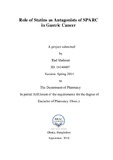| dc.contributor.advisor | Kabir, Dr. Eva Rahman | |
| dc.contributor.author | Shahmat, Rad | |
| dc.date.accessioned | 2019-01-03T05:23:06Z | |
| dc.date.available | 2019-01-03T05:23:06Z | |
| dc.date.copyright | 2018 | |
| dc.date.issued | 2018-09 | |
| dc.identifier.other | ID 14146007 | |
| dc.identifier.uri | http://hdl.handle.net/10361/11074 | |
| dc.description | This project report is submitted in partial fulfilment of the requirements for the degree of Bachelor of Pharmacy, 2018. | en_US |
| dc.description | Catalogued from PDF version of project report. | |
| dc.description | Includes bibliographical references (page 35-40). | |
| dc.description.abstract | Cancer refers to the abnormal and uncontrollable growth of cells in the body. It is the second leading cause of death in the world and in 2015 alone claimed the lives of 8.8 million people. The protein SPARC (Secreted Protein Acidic and Rich in Cystine) plays an important role in wound healing, bone formation, tumor progression, fibrosis and angiogenesis. Maintaining the normal level of SPARC in the human body is very important as deviation from the normal level of SPARC in the body can hamper bone mineralization, cell proliferation and extracellular matrix synthesis process. SPARC acts as both cancer promoter and cancer suppressor, which makes it a possible target for anti-cancer drug development. In gastric cancer, SPARC acts as a tumor promoter and downregulating the production of it showed better prognosis of the disease. In this study, drug repurposing and other in silico computational techniques have been used to find a potential statin antagonist of SPARC which will inhibit and lower the production of SPARC in gastric cancer cells. PyRx was used to carry out the molecular docking of statin drugs with SPARC and Discovery studio was used to check the drug-protein interaction. Ramachandran plot and z-score were used to validate the protein structure of SPARC. The z-score of SPARC was found to be -7.91. Initially over 200 small molecules were chosen and docked with the SPARC protein, which included two classes of drugs, anti-inflammatory drugs and statins. Among them statin drugs were finally chosen on the basis of binding affinity and stability. The potential statin drugs which were finally selected were atorvastatin, simvastatin, pitavastatin and pravastatin. Among them, atorvastatin showed one of the highest binding affinity of -9.6Kcal/Mol. The aim of this study was to find a statin drug which targeted and bound to SPARC and prevented its expression and atorvastatin fulfilled the criteria. The study shows that atorvastatin, for its high binding affinity towards SPARC could be used as an anti-cancer drug for gastric cancer by reducing the expression of SPARC. | en_US |
| dc.description.statementofresponsibility | Rad Shahmat | |
| dc.format.extent | 40 pages | |
| dc.language.iso | en | en_US |
| dc.publisher | BRAC University | en_US |
| dc.rights | BRAC University project reports are protected by copyright. They may be viewed from this source for any purpose, but reproduction or distribution in any format is prohibited without written permission. | |
| dc.subject | Cancer | en_US |
| dc.subject | SPARC gene | |
| dc.subject | Anti-cancer drug | |
| dc.subject.lcsh | Stomach--Cancer. | |
| dc.title | Role of statins as antagonists of SPARC in gastric cancer | en_US |
| dc.type | Project report | en_US |
| dc.contributor.department | Department of Pharmacy, BRAC University | |
| dc.description.degree | B. Pharmacy | |

